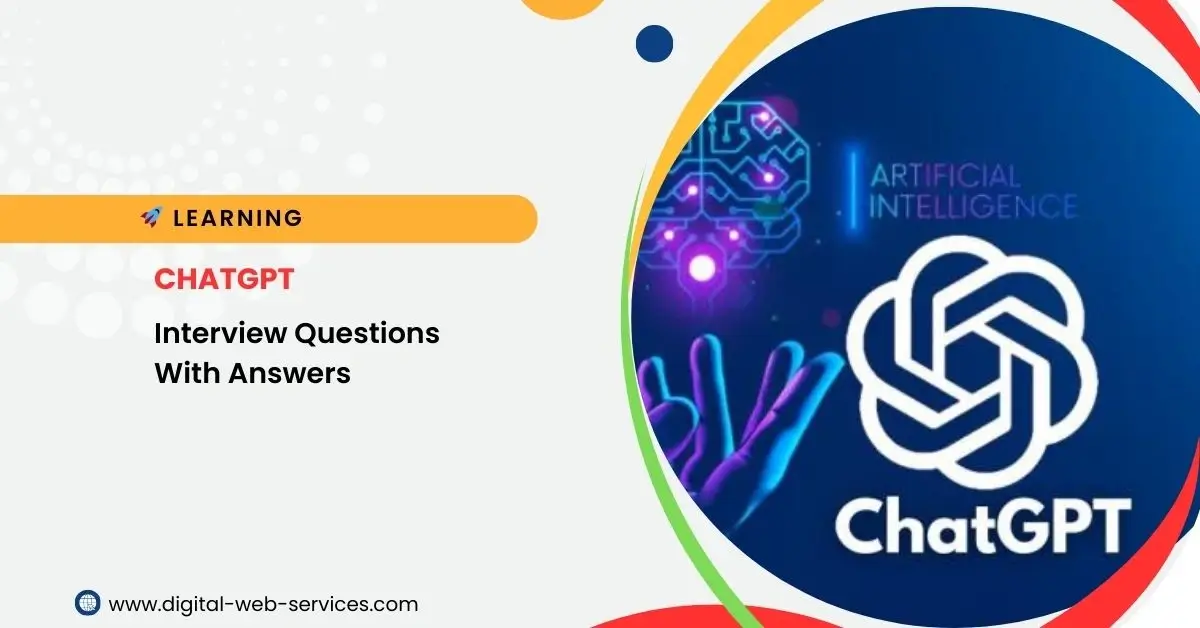
In this article, we’ve compiled over 50 commonly asked interview questions related to ChatGPT (or similar AI language models) along with short, to-the-point answers. These questions cover a variety of aspects, from basic concepts to more advanced technical topics.
50+ ChatGPT Interview Questions and Answers With Examples
1. What is ChatGPT?
Answer: ChatGPT is an AI language model developed by OpenAI that uses deep learning to generate human-like text based on the input it receives.
2. How does ChatGPT work?
Answer: ChatGPT works by predicting the next word in a sentence based on the previous words using a transformer architecture.
3. What is GPT?
Answer: GPT (Generative Pre-trained Transformer) is a deep learning model designed for natural language processing tasks such as text generation, translation, and summarization.
4. Who developed ChatGPT?
Answer: ChatGPT was developed by OpenAI, an artificial intelligence research organization.
5. What is a transformer model?
Answer: A transformer model is a type of deep learning model that processes input data in parallel, rather than sequentially, making it more efficient for tasks like language processing.
6. What does “pre-trained” mean in GPT models?
Answer: “Pre-trained” means the model has been trained on large datasets to learn language patterns before being fine-tuned for specific tasks.
7. What is fine-tuning in ChatGPT?
Answer: Fine-tuning is the process of training a pre-trained model on a smaller, task-specific dataset to improve its performance on a particular task.
8. What are the applications of ChatGPT?
Answer: ChatGPT can be used for customer support, content generation, virtual assistants, language translation, and more.
9. What are the limitations of ChatGPT?
Answer: ChatGPT can generate incorrect information, struggle with reasoning, and might produce biased outputs based on its training data.
10. What is the difference between GPT-3 and GPT-4?
Answer: GPT-4 is an improved version of GPT-3 with better performance in complex tasks, more understanding of context, and fewer biases.
11. How can you use ChatGPT in business?
Answer: ChatGPT can be used for automating customer service, content creation, lead generation, and data analysis.
12. Is ChatGPT capable of learning from users?
Answer: ChatGPT doesn’t learn or retain information from individual interactions unless explicitly retrained with new data.
13. What is a token in ChatGPT?
Answer: A token is a unit of text that ChatGPT processes, which could be as short as a character or as long as a word, depending on the language.
14. How can you ensure the responses from ChatGPT are accurate?
Answer: You can prompt ChatGPT with clear and specific instructions, and verify outputs using external sources when necessary.
15. What is the temperature setting in ChatGPT?
Answer: Temperature controls the randomness of the output. A higher value (e.g., 1.0) makes outputs more creative, while a lower value (e.g., 0.2) makes them more deterministic.
16. Can ChatGPT replace human customer service?
Answer: ChatGPT can assist with simple inquiries and repetitive tasks, but human customer service is still needed for complex issues and emotional intelligence.
17. What is zero-shot learning?
Answer: Zero-shot learning refers to a model’s ability to perform a task without having seen examples of it during training.
18. What is a prompt in ChatGPT?
Answer: A prompt is the input or question you provide to ChatGPT to generate a response.
19. Can ChatGPT understand multiple languages?
Answer: Yes, ChatGPT can understand and generate text in multiple languages, though its performance varies depending on the language.
20. What is the role of attention in transformers?
Answer: Attention mechanisms in transformers allow the model to focus on important parts of the input sequence, improving context understanding.
21. What is a generative model?
Answer: A generative model creates new data instances, like text or images, based on patterns learned from the training data.
22. How do you prevent biases in ChatGPT?
Answer: OpenAI actively works to reduce biases through better training datasets, reinforcement learning, and fine-tuning methods.
23. What is the training dataset of ChatGPT?
Answer: ChatGPT was trained on a large corpus of text data, including books, websites, and other publicly available content.
24. How does ChatGPT handle ambiguous queries?
Answer: ChatGPT may try to provide the most likely response based on context, but may also ask for clarification when needed.
25. Can ChatGPT create code?
Answer: Yes, ChatGPT can generate code snippets, debug code, and explain programming concepts in various programming languages.
26. What are few-shot learning capabilities?
Answer: Few-shot learning refers to a model’s ability to learn and generalize from just a few examples provided during the task.
27. What is tokenization?
Answer: Tokenization is the process of breaking down text into smaller units (tokens) like words or characters for easier processing by the model.
28. What do you mean by “context window”?
Answer: The context window refers to the amount of previous text the model uses to generate a response, typically limited by the model’s token capacity.
29. How can ChatGPT be integrated into a website?
Answer: ChatGPT can be integrated via APIs, allowing users to interact with the model directly on a website for customer support or chatbots.
30. What is the role of reinforcement learning in ChatGPT?
Answer: Reinforcement learning helps fine-tune the model by rewarding it for generating more appropriate and relevant responses based on feedback.
31. Can ChatGPT summarize articles?
Answer: Yes, ChatGPT can summarize long articles, pulling out key points and generating concise summaries.
32. Can ChatGPT generate creative content like poems or stories?
Answer: Yes, ChatGPT can generate poems, stories, and other creative content based on prompts.
33. What is adversarial training?
Answer: Adversarial training involves training models with intentionally modified data to make them more robust against malicious inputs or errors.
34. What is the maximum token limit in ChatGPT?
Answer: The token limit varies between models but typically ranges from 4,096 to 8,192 tokens for a single input-output pair.
35. How can ChatGPT assist in SEO?
Answer: ChatGPT can generate SEO-friendly content, suggest keywords, and assist in creating optimized meta descriptions or blog posts.
36. What is the “stop sequence” in ChatGPT?
Answer: A stop sequence is a specific token or phrase that signals ChatGPT to stop generating more text.
37. Can ChatGPT handle complex mathematical problems?
Answer: ChatGPT can solve basic to intermediate math problems, but its accuracy may decrease for complex or highly specialized mathematics.
38. What is a conversational AI model?
Answer: A conversational AI model is designed to simulate human-like dialogue and engage in dynamic conversations, like ChatGPT.
39. Can ChatGPT write essays?
Answer: Yes, ChatGPT can write essays on a variety of topics, generating coherent and structured content.
40. What is the “nucleus sampling” method?
Answer: Nucleus sampling is a technique used in text generation that focuses on a smaller subset of possible next words, improving output quality.
41. What is beam search?
Answer: Beam search is a search algorithm that generates multiple candidate outputs and selects the one with the highest probability.
42. Can ChatGPT be used for translation?
Answer: Yes, ChatGPT can translate text between various languages, although specialized translation models may be more accurate.
43. How does ChatGPT handle sarcasm or humor?
Answer: ChatGPT may recognize sarcasm or humor in context but could misinterpret subtle nuances.
44. Can ChatGPT write code documentation?
Answer: Yes, ChatGPT can generate documentation for code, explaining functions, variables, and logic.
45. What are the ethical concerns regarding ChatGPT?
Answer: Ethical concerns include bias, misinformation, privacy issues, and the potential for misuse in malicious applications.
46. How can ChatGPT help in education?
Answer: ChatGPT can assist in tutoring, generating practice questions, summarizing lessons, and explaining concepts in a variety of subjects.
47. What is a language model’s perplexity?
Answer: Perplexity is a measure of how well a language model predicts a sample, with lower values indicating better performance.
48. What is reinforcement learning with human feedback (RLHF)?
Answer: RLHF is a technique used to fine-tune models by incorporating feedback from humans to improve the quality of responses.
49. Can ChatGPT generate diagrams or images?
Answer: No, ChatGPT is primarily a text-based model, but it can describe or guide the creation of diagrams and images.
50. What are the key challenges in training a language model like ChatGPT?
Answer: Challenges include handling biases, ensuring accuracy, managing large-scale data, and mitigating harmful or inappropriate content.
Last Word
This list of 50+ questions and answers provides a solid overview of ChatGPT, its capabilities, and the underlying technologies. Whether you’re preparing for an interview or simply curious about AI, these questions will help you understand the core concepts and applications of ChatGPT.
Digital Web Services (DWS) is a leading IT company specializing in Software Development, Web Application Development, Website Designing, and Digital Marketing. Here are providing all kinds of services and solutions for the digital transformation of any business and website.










